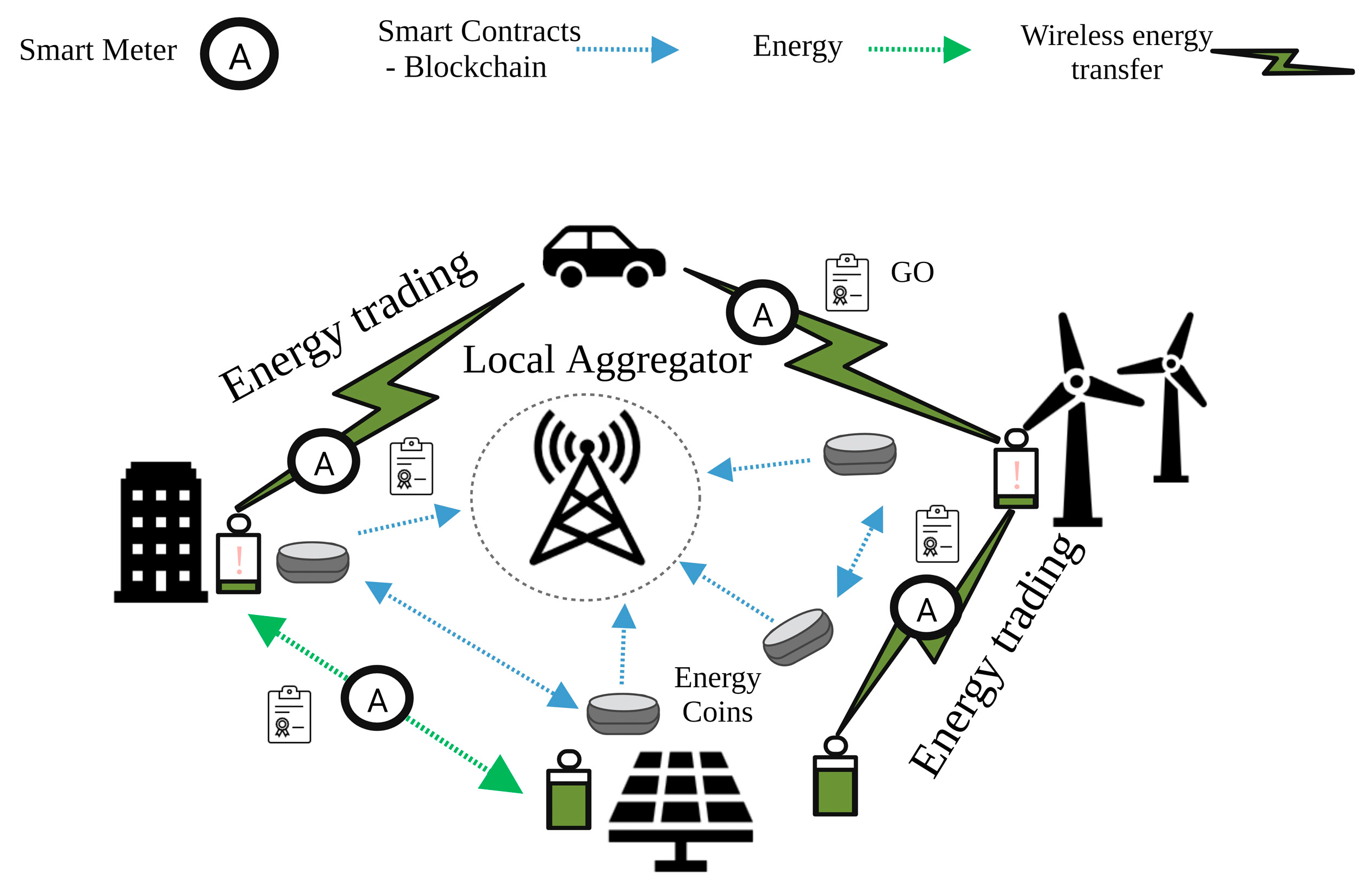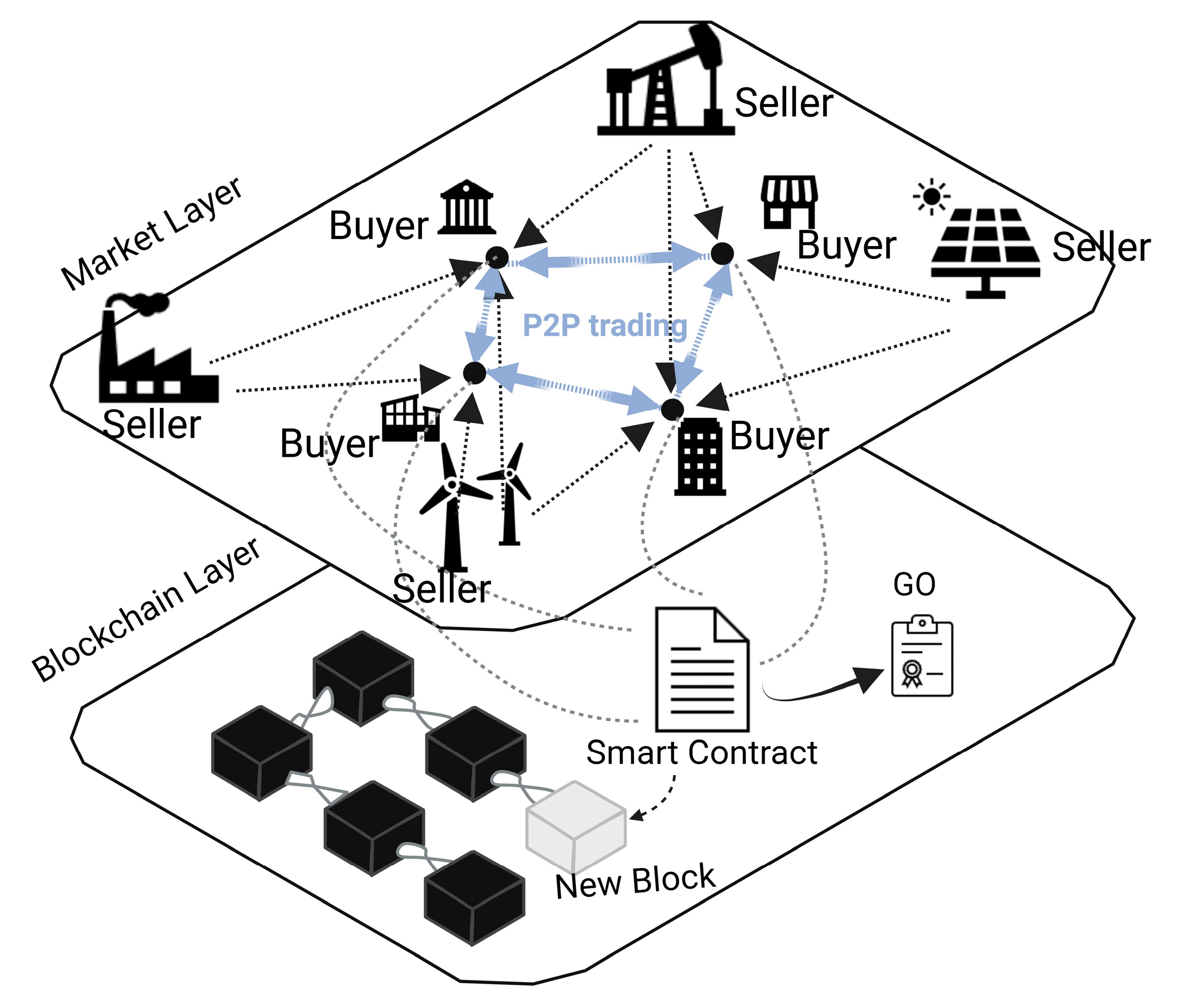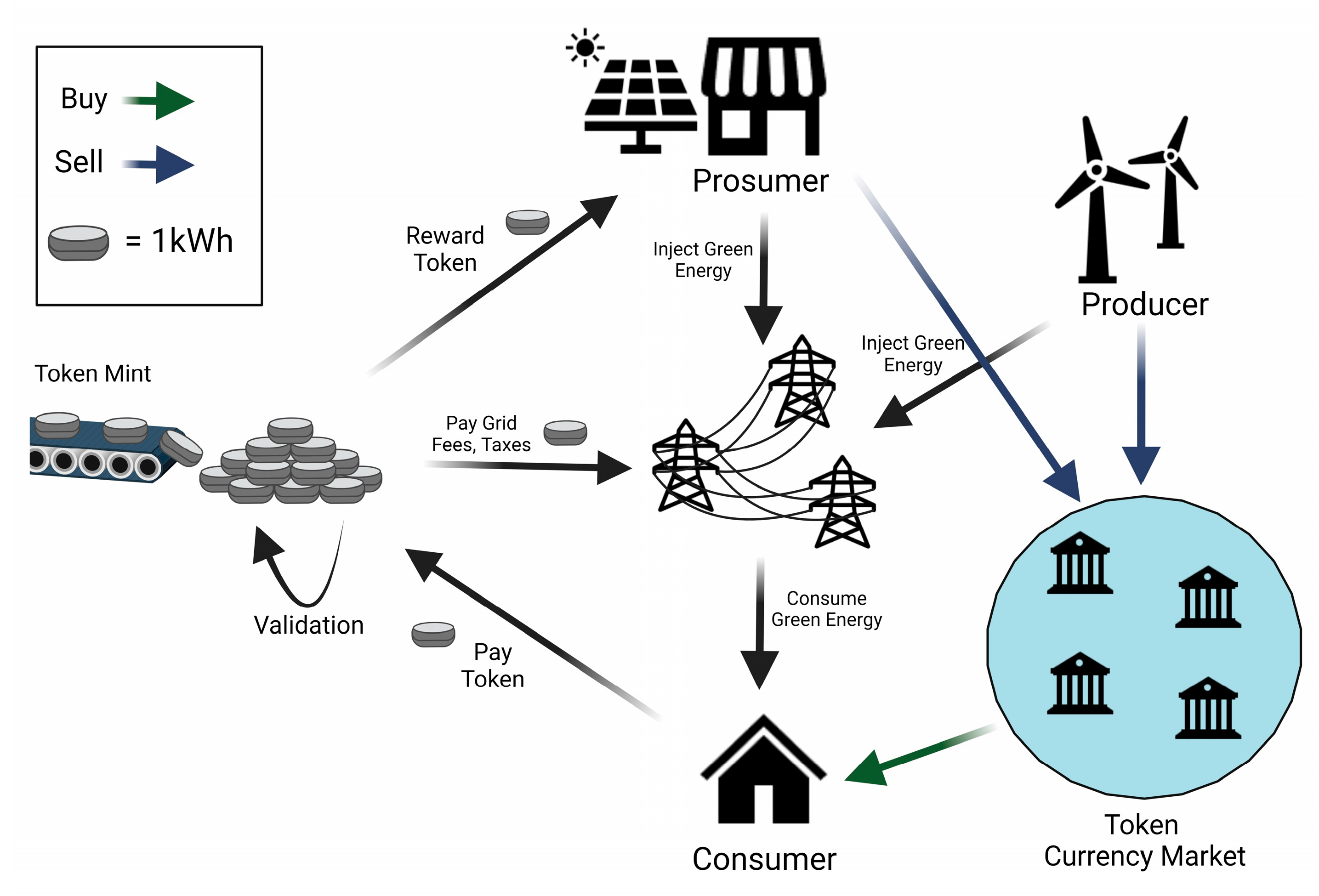Guarantees of Origin (GOs) are widely used as insurances for the renewability of electricity supplies and proofs of compliance to renewable standards; however, they suffer from structural problems. Their transactional history cannot distinguish between those traded among market actors and the ones that come directly from power plants, giving rise to transparency issues. Certificate trading dissuades producers from investing in an increase in renewable capacity resulting in lack of additionality while complex frameworks and administrative structures emerge to keep track of the vast network of GOs. These issues can be resolved through the introduction of blockchain networks which can provide transparency and help incentivise renewable investment while increasing automation and process simplification.
1. Guarantees of Origin
Guarantees of Origin, or Renewable Energy Guarantees of Origin (REGOs) in the UK are certificates that provide proof that a given quantity of energy has been generated from renewable sources and can be issued by a participating country’s designated regulatory body (i.e., Ofgem in the UK) to the producer
[1].
In the current system, the relevant issuing authority allocates GOs to produced units of electricity after voluntary request from a generator. In countries compliant to the European Energy Certificate System’s standards such as the UK, generation data is submitted through a register and GO certification is awarded within the system which allows transfer to other account holders
[2], This makes GOs tradable commodities where they can be traded electronically in the voluntary electricity certificates market which is separate to the power market and therefore to the physical delivery of electricity to consumers.
In recent years, GOs have come to play a significant role in carbon accounting as corporate standards now require organisations to quantify emissions acquired from electricity consumption (Scope 2 emissions)
[3]. Consequently, corporations interested in reducing their carbon footprint have turned to renewable sources. Considering that electricity is overwhelmingly purchased via power markets and is transmitted through national grids, the volume of electricity delivered to a user node cannot be traced back to a producer node because it has been mixed with the available capacity in the network upon injection to the system. Directing electricity from different sources such as renewables, gas or other fuels to specified users is therefore impossible and verifiable proofs of origin in the form of renewable certificates are necessary to demonstrate renewable purchases and compliance with carbon standards.
2. Possibilities for Blockchain-Enabled Guarantees of Origin
While the benefits of blockchain for energy certification might seem straightforward after the technology’s characteristic have been examined, widescale implementation has not yet been made available. This may cause considerable asymmetry of information across the energy industry which still lacks technical knowledge to enforce the necessary organisational changes, and it might inhibit implementation attempts and learning-by-doing which are paramount for the growth of such niche practices. Companies that are interested in the concept may be uncertain about the means or the costs that are involved to reconfigure their systems accordingly. Below are some of the current options to secure Guarantees of Origin through blockchain networks that are available to energy retailers and buyers.
2.1. Smart Grids
Blockchain offers new opportunities for the rethinking of energy certificates. The technology is already used or explored in several aspects of energy systems, and this can allow for the integration of energy authentication within these new structures. For example, Blockchain solutions for energy trading are discussed by an increasing body of literature that deals with smart grids and microgrids. In such cases, blockchain energy trading commonly comprises nodes which can be buyers or sellers and energy aggregators, that can be metering infrastructures or computing stations which act as energy brokers and manage trading-related events between different nodes through the execution of smart contracts
[4][5].
These technologies offer the necessary flexibility and decentralised functionalities to accommodate the rising demand for system integration, real-time information sharing and optimisation of energy management and energy traders can be beneficiaries of cost reductions, increased efficiency, automation, transparency and reduction of capital requirements for energy firms, allowing for smaller players to compete in the market
[6][7]. Benefits can also be realised for consumers and prosumers in the form of reduced energy prices and incentivisation of investment in renewable energy sources
[6].
The advance of the Internet of Things in the industry (IIoT) provides new opportunities for peer-to-peer (P2P) energy trading among nodes. Energy trading can be between connected powered devices via traditional infrastructure such as the power grid, but also between remote devices that are not physically connected
[8]. Advanced wireless communication and data processing will be necessary for reliable data transfer between the “supplier” and “consumer” devices and types of blockchain networks, such as consortium blockchain a federated solution with nominated nodes driving consensus protocols, have been proposed as highly suitable to ensure fast, secure, and efficient energy trading
[4]. Similarly, Tan et al., (2019) propose an energy blockchain network (EBN) which comprises two blockchain sets, where buyers and sellers are matched based on transaction and volume broadcasts sent through one set, while transactional information once the trade is formed is stored to the other, preserving the privacy and security of participants and minimising system energy costs through the use of smart contracts and the Lagrange relaxation methodology
[5]. The MultiLevel and MultiChain Information Transmission Model which centralises scheduling instructions while maintaining the autonomy of agents to initiate energy transactions, has also been proposed as an blockchain-enabled process that ensures information security
[9]. Applications of blockchain concepts to create autonomous localized energy markets are still at an early stage but are demonstrated to increase financial incentives for renewable capacity and benefit grid balancing
[10]. Companies such as FlexyGrid, or UrbanChain create localized and decentralized peer-to-peer energy trading ecosystems enabled by blockchain, artificial intelligence and Internet of Things technologies to back renewable energy solutions
[11][12] (
Figure 1).
Figure 1. Smart grid decentralised blockchain architecture with advanced wireless communication and data processing as a reliable and traceable energy trading and certification mechanism.
It is apparent that as IoT systems grow, distributed shared databases or devices with data storing abilities will be able to record and preserve information about the origins of energy volumes as part of P2P energy trading blockchain networks. This can greatly facilitate the establishment of GOs as information can be easily accessible and verifiable by relevant parties. Depending on the blockchain structure the involvement of third parties and intermediaries that play a role in the issuing of energy certificates might be reduced or entirely withdrawn as the market will be less reliant on central authorities and information will be accessible to a greater number of network users. Consequently, energy volumes will be reliably traceable from source to consumption successfully coupling energy production and procurement and providing buyers with adequate information for market-based Scope 2 accounting.
2.2. Energy Trading Platforms and Decentralised Applications
With the advent of the imminent digital revolution, European energy firms such as Iberdrola and Acciona Energia are among the ones to embrace digital infrastructure and blockchain to authenticate energy for corporate consumers
[13][14]. The blockchain-enabled decentralised application (dApp), EW Origin that is used by these firms, provides a dedicated platform for P2P energy transactions outside the regulated market that are anonymously and securely verified by other operator nodes and accelerates renewable certification processes
[15].
Open-source platforms can integrate dApps and provide transparency, security and traceability of energy transactions and origins. A notable example of this is Pylon Network, which is a neutral energy blockchain database, that stores information from energy stakeholders and allows users to trade energy, share or manage their data according to their needs, providing a secure way to obtain energy certificates and other carbon credits through its marketplace services
[16][17]. Using a federated nodes architecture the network uses the Pyloncoin (PYLNC) as a digital currency for payments within the community but also to act as an advance green labelling mechanism to certify the renewable attributes of traded energy and completely integrate with the GO scheme
[18]. Gains in additionality are also achieved through the distribution of part of mined PYLNC to green producers and prosumers, incentivising growth in investment in renewable generation technologies
[18].
Similarly, the Energy Web Chain offers another open-source blockchain platform that hosts dApps which enable energy markets to fulfil regulatory, operational and market need, including renewable certification, supported by firms such as the French electricity utility Engie
[16][19]. Other worthy mentions include EXERGY, PowerLedger or WePower, that offer alternative solutions on trading and energy certificates among other services
[16][20].
Blockchain platforms offer an alternative space for energy trading and data exchange for organisations that are interested in greater transparency and efficiency to implement alongside their normal energy procurement. The open-source basis greatly reduces entry and use costs and participants have the opportunity to maximise efficiency and control by freely tailoring the software to fit their organisational processes. While a wider implementation of smart grid technologies will most likely benefit blockchain platforms in the long term, at present these solutions do not necessitate significant infrastructural investment in the forms of IoT equipment and software to realise transparency benefits therefore providing a cheaper, quicker, and more flexible option (Figure 2).
Figure 2. P2P trading platforms with Blockchain as an alternative space for energy trading and data exchange.
2.3. Energy Tokens
Energy can become a quantifiable asset and a tradeable commodity in the form of a cryptocurrency. Based on the decentralised and trust less principles of blockchain technology, energy units can be converted to cryptocurrency tokens (coins) and be bought or sold through smart contracts. While the price of the tokens is determined by the same laws of supply and demand that govern other commodities their value will always represent a specified unit of electricity (i.e., 1 kWh or 1 MWh) and thus is closely tied to the retail cost of energy reducing the likelihood of speculative bubbles seen in other cryptocurrencies. Tokens can be exchanged for other fiat or crypto currencies in the currency market
[16]. Prominent examples of this are the NRGCoin or KWHCoin which can be used to pay for renewable electricity made available from the producers participating in the scheme.
In the case of NRGCoin, consumers use the tokens to “acquire” and withdraw energy from the system using smart contracts to pay the necessary electricity costs and fees at prices determined by the maximum supply and demand for a 15 min interval
[21]. Payments are automatically converted to fiat currencies through third-party currency exchanges if the utility or system operator do not accept cryptocurrencies. The granularity and method by which the value of electricity is determined provides a fairer rewarding method and further incentives generators to participate and balance local production and consumption as compared to the conventional market mechanisms such as Feed-In-Tariffs (FiT) which pay for injected energy over a year period regardless of whether over or under production has occurred (
Figure 3).
Figure 3. Blockchain cryptocurrencies as a reliable method to certify renewable energy procurement.
Energy tokenisation through blockchain can indeed provide another method to certify renewable energy and solves all three of the issues that limit the effectiveness of GOs, namely lack of transparency, additionality or simplicity whilst also offering a cheaper and more flexible solution than blockchain-enabled energy trading platforms or smart grid. Despite its numerous advantages this approach may face significant challenges to retain its incentives intact in the long term. While a decreasing minting rate may be able to retain financial returns on investment for generators over time as participation increases, standardisation and scalability may be hindered if further integration with energy market mechanisms and regulations proves infeasible or too slow
[22]. Currently, blockchain-powered energy token solutions might be suitable for smaller electricity consumers that are willing to experiment and become familiar with the concept (
Table 1).
Table 1. Renewable certificate—GO challenges that can be addressed by blockchain solutions.








